
by Matt Lollar | May 27, 2019
Nobody likes weeds in their garden. Weeds are not only ugly, they can host insects and diseases that later spread to your garden. This situation commonly occurs when weeds belong to the same plant family as the desired landscape or vegetable species, but some insects and diseases have diverse palettes. For example, I recently witnessed a looper caterpillar on a pokeweed plant.

Looper damage on a pokeweed plant. Photo Credit: Matt Lollar, University of Florida/IFAS Extension at Santa Rosa County
Loopers are common pests of vegetable gardens and in the landscape. Probably the most common loopers found in North Florida gardens are cabbage loopers (Trichoplusia ni) and soybean loopers (Chrysodeixis includens). Cabbage loopers can be found feeding on cabbage, of course, as well as leafy greens, cucumbers, tomatoes, chrysanthemums, and snapdragons. Weeds that attract this looper are lambsquarters, dandelions, and curly dock. Soybean loopers like to feed on sweet potatoes, tomatoes, watermelons, geraniums, and sunflowers. They can also be found feeding on oxalis, kutzu, and lantana.
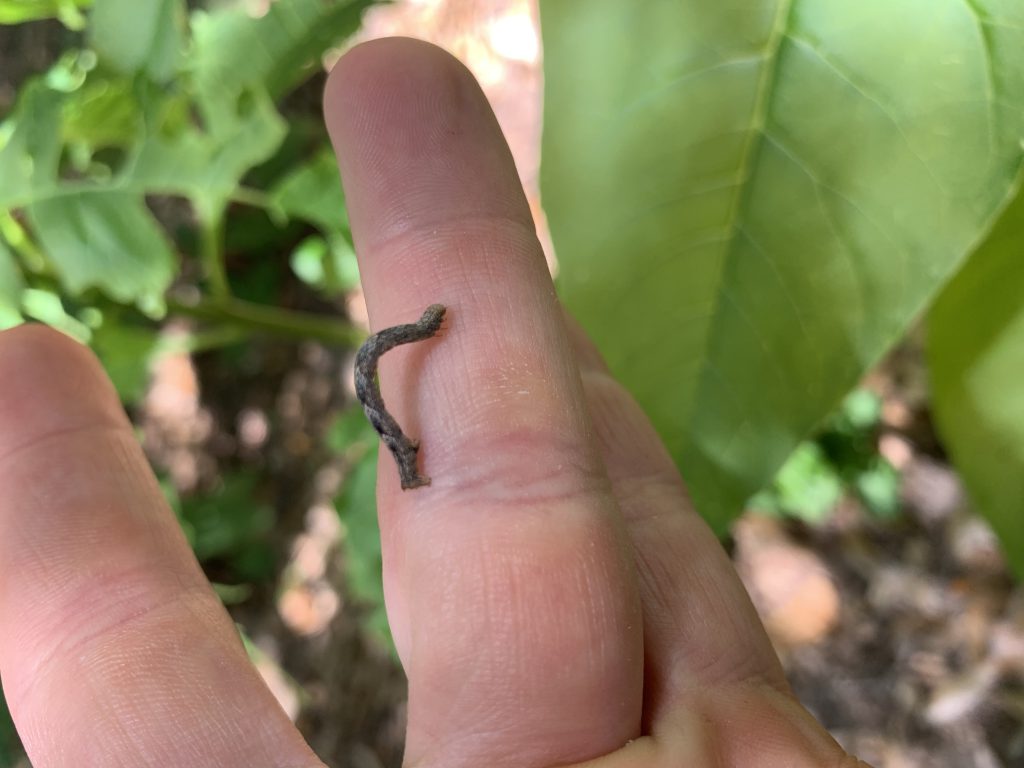
Looper found on pokeweed plant. Photo Credit: Matt Lollar, University of Florida/IFAS Extension at Santa Rosa County
Although weeds can be hosts for pests, they may be used advantageously. Trap crops can be planted at a garden’s perimeter or windward portion to attract pests away from the desired crop. A trap crop draws the pest crop away from the main crop. The trap crop is then destroyed or sprayed with insecticide when the pest insect is found feeding on it. This allows for a reduction or elimination of insecticidal use on the desired crop. However, it is important that both the trap crop and the desired food crop or ornamental crop are regularly scouted to keep track of pest populations.
For more information on trap crops and other insect and disease diversion methods you can read the EDIS Publication: Intercropping, Crop Diversity and Pest Management.
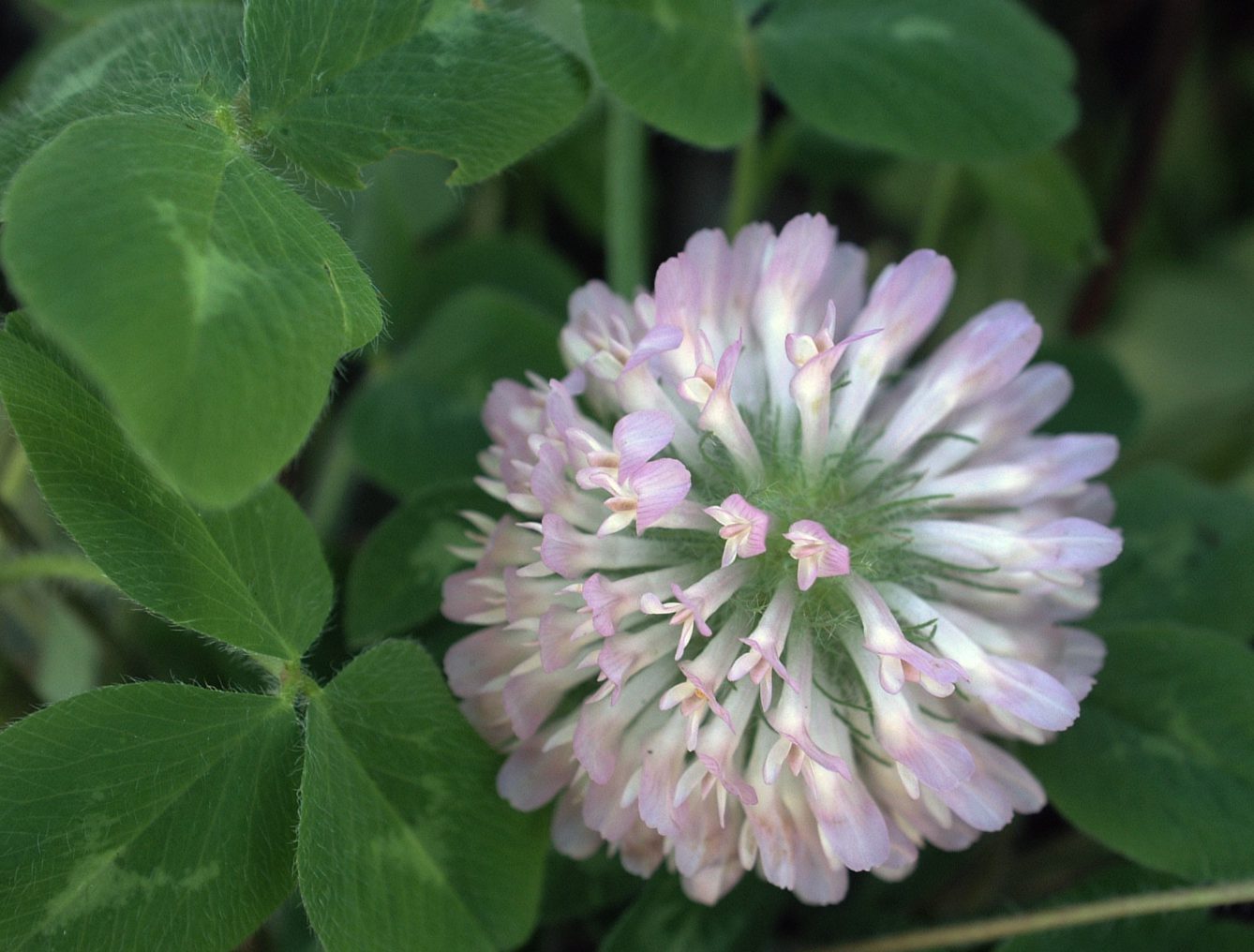
by Matt Lollar | Mar 5, 2019
Many gardeners plant a spring vegetable garden with a number of different vegetable types, which is excellent because a diverse and varied garden is proven to improve soil health. Intercropping is a gardening practice of growing different crops in the same field. When planting a mixture of crops in the same field year after year, it is important to rotate the location of each type of vegetable. This is a practice known as crop rotation. Intercropping and crop rotation will help reduce insect pest populations, increase beneficial insect populations, and reduce weed populations .
Crop Diversity
Including plants that pest insects don’t like to eat in a garden forces the pests work harder to find what they find palatable. Studies have found reduced whitefly numbers on squash plantings mixed with a crop of buckwheat when compared to squash planted alone. Another crop mixture that may be unintentional, but may be favorable, is a crapemyrtle stand along a garden’s edge. Crapemyrtles will attract the crapemyrtle aphid which will attract predatory insects. When the predatory insects run out of crapemyrtle aphids to eat, they will move to the vegetable garden and begin to hunt pest insects.

Squash with living mulch of buckwheat. Photo Credit: Oscar Liburd, UF/IFAS Extension
Trap Cropping
A trap crop is a plant that attracts a pest insect away from your food crops. Trap crops work best when planted at the garden’s edge, along a fence row, or in movable containers. A bare space, let’s say 5 feet or so, should be kept between trap crops and vegetable plantings. This will help keep the pests from moving desirable crops plants. When a large population of pests are found on the trap crop then it is time to spray them with insecticide, or cut the crop down and remove or destroy the debris. If trap crops are planted in containers, then it makes them much easier to remove from the garden when necessary.
Cover Crops and Green Manure
Soil organic matter can be increased by the use of green manure and cover crops. Cover crops are generally planted during the off-season, but they can be planted in between vegetable rows and tilled in at a designated time as a green manure. Both cover crops and green manure improve garden production by:
- Suppressing weeds by competing for water, light, and nutrients;
- Holding the soil in place and preventing erosion;
- Scavenging for nutrients that can be utilized in future crops;
- Reducing nematode populations;
- Providing a habitat for beneficial insects.
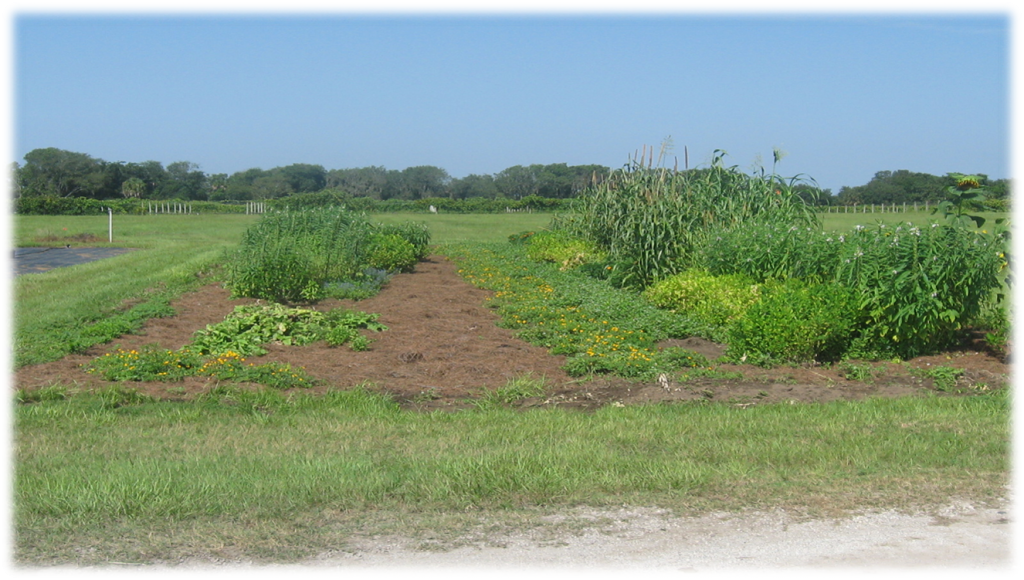
A mixed plot of cover crops and trap crops. Photo Credit: Matt Lollar, UF/IFAS Extension – Santa Rosa County
A number of different crops can serve as cover crops or green manure crops. Most are legumes (bean family) or grasses. A few that should be tried are:
- Cowpeas
- Sunn hemp
- Sorghum-sudangrass
- Winter rye
More detailed information on cover crops and green manure can be found at this link: http://edis.ifas.ufl.edu/aa217.
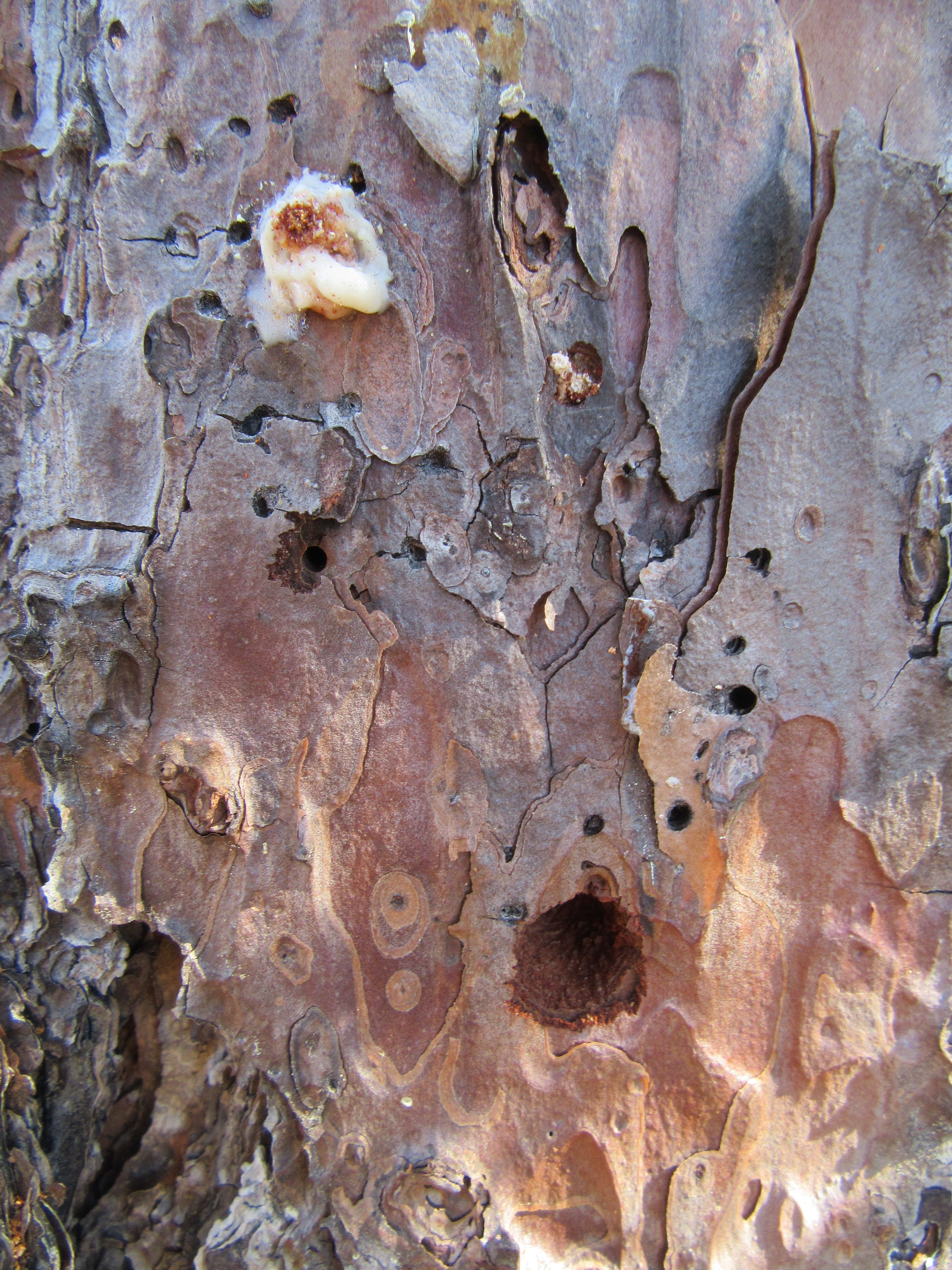
by Matt Lollar | Nov 20, 2017
Sometimes you don’t realize a tree is dying until it is dead. A few weeks ago, we got a call from a client who said he had insects killing his trees. Before having someone drive out to the property, our Master Gardener volunteer recommended that the client bring in some of the insects for us to take a look. It turned out the insects invading his pine tree were a type of longhorned beetle, but more specimens were required for identification. A site visit soon ensued.
There were a number of pine trees on the property, however only one was infested with the insects in question. Upon closer investigation, we noticed a number of different sized holes in the tree. The larger holes are nearly the size of a dime.
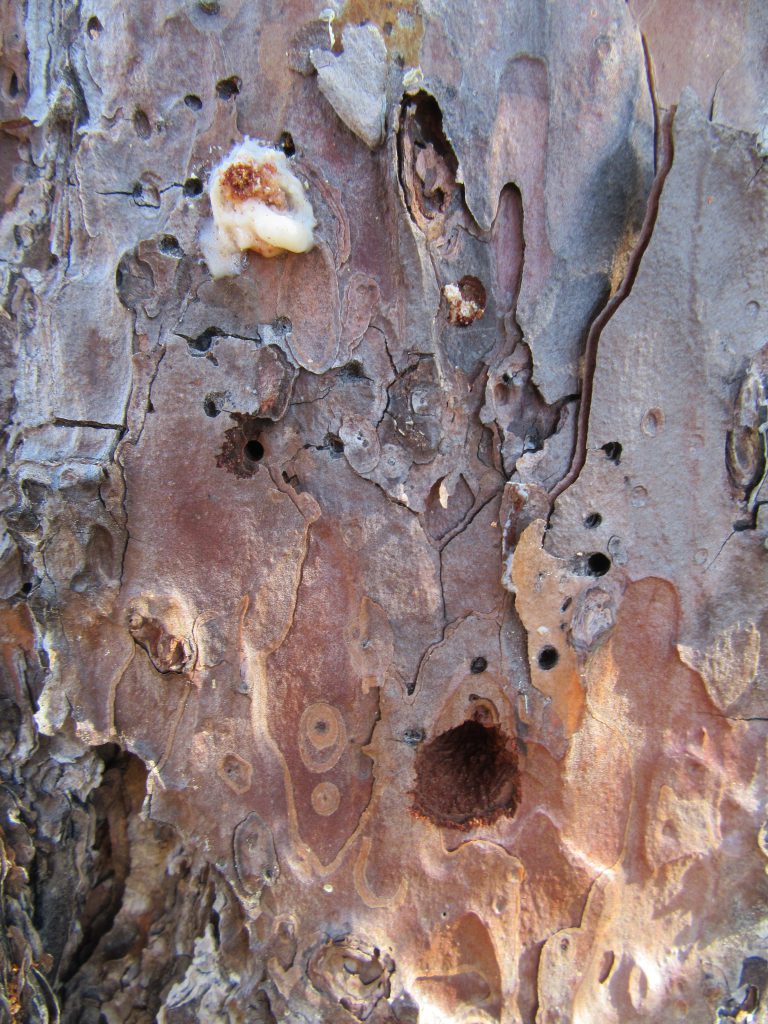
Arrowhead borer damage on a pine tree. Photo Credit: University of Florida/IFAS Extension.
It turns out the insects making the larger holes are a type of longhorned beetle known as an arrowhead borer (Xylotrechus sagittatus). The borers are brown to black in color with a reddish hue. They are moderately hairy and some specimens contain arrowhead markings pointing toward their heads. Adults feed on the bark of damaged or fire-killed pines. The adults are attracted to lights and may be mistaken for crickets because they run very fast. Eggs are laid in bark and larvae feed on sapwood, then tunnel deeper, often tunneling within a single annual ring. The borers pupate inside the tree and the newly emerged adults chew their way out.
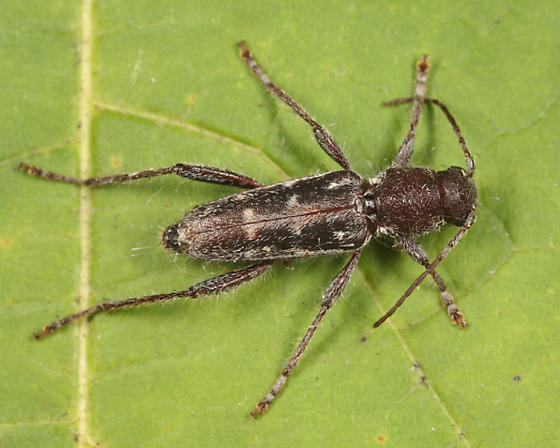
Arrowhead Borer. Photo Credit: Tom Murray bugguide.net.
Given the fact that arrowhead borers are attracted to dead or dying trees, the killer of this particular tree is still in question. The smaller holes in the bark picture above were created by a much smaller beetle, but we were unable to get a specimen. We did see a couple of these beetles running around when we dug deeper into the bark. The small beetles that we saw closely resembled a type of Ips engraver beetle. Beetles in this genus have been known to kill trees, but most likely they weren’t the culprits either. Based on the overall appearance of the tree and the fact that other trees in the area were not infested with beetles, it is believed the tree was killed by other means. The tree was likely struck by lightening or suffered from poor genetics because it did not have a good form for a pine tree.
If you have a questionable looking tree on your property or if you have insects you would like identified, please feel free to stop by your local Extension Office and ask a Master Gardener!
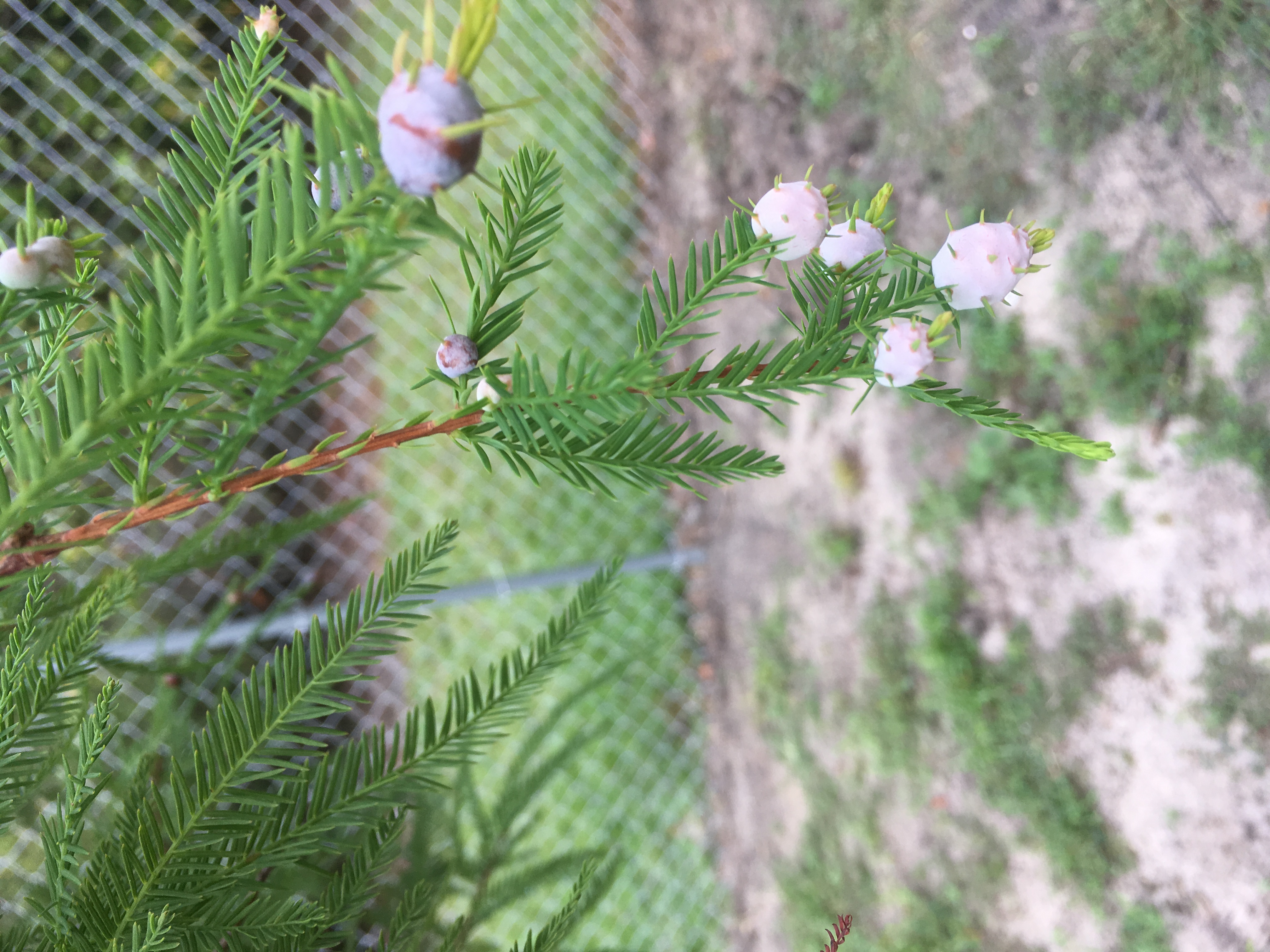
by Julie McConnell | Oct 23, 2017

Cypress twig galls on bald cypress leaves. Photo: J_McConnell, UF/IFAS
Bald cypress Taxodium distichum is a native tree that is commonly planted in landscapes because it is adaptable to many sites and grows quickly. It is an interesting tree because it has soft flat leaves that fall off in the winter like other deciduous shade trees; however, it belongs to the Cypress family which consists mostly of needled evergreens.
Like the other cypresses, bald cypress produces cones in the fall, which is a primary means of reproduction for the species in natural settings. During the same season that cones are maturing, you might also see what looks like cones forming at the tips of branches among the leaflets rather than along the stem. These mysterious growths are not cones but rather twig galls.
Bald cypress twig galls are abnormal growths of leaf bud tissue triggered by the attack of the cypress twig gall midge Taxodiomyia cupressiananassa. In late spring, adult midges lay eggs on new leaves of the bald cypress. As the eggs hatch and midge larvae start feeding on the bald cypress leaves the growth of a twig gall is induced. The larvae take advantage of this gall using it for food and shelter throughout the larval stage and into the pupal stage. After pupation, adults emerge from the galls, mate, and females lay an average of 120 eggs over a two-day lifespan as an adult. This first generation lays eggs on mature leaves which starts the cycle again. The galls formed by the second generation of the year fall off and overwinter on the ground.
The galls do not appear to affect the health of trees overall, although the weight of heavily infested branches may cause drooping. There are many natural enemies of the twig cypress gall midge, so applying insecticides are not recommended since they may cause harm to non-target insects. The simplest management option is to collect and destroy the galls in the spring and fall to reduce populations the following season.
To read more about bald cypress trees or the twig gall please see the following publications:
by Larry Williams | May 11, 2017

Adult Ladybug. Photo Credit: James Castner University of Florida
A number of summers ago, I noticed whiteflies on a confederate rose plant in my landscape. I considered using an insecticide to control the whiteflies but decided against doing so after taking a closer look. What I found was a population of ladybugs – eggs, larvae, pupae and adults.
Ladybug adults and larvae eat whiteflies, as well as other soft-bodied insects such as aphids. So, I waited to see what would happen.
At first I was seeing mostly adult whiteflies, which look like tiny white moths. Adult whiteflies mate and then lay eggs on the underside of leaves. The eggs hatch into flat translucent scale-like nymphs that suck the “juice” from the underside of the leaves.
Eventually, some of the leaves developed a black coating called sooty mold. As certain insects (primarily aphids, some scales and whiteflies) feed, they excrete plant sap that coats the leaves. Sooty mold then grows on this sugary sap. It’s not a pathogen. It just makes the leaves look ugly.
Knowing that the whiteflies would not kill the confederate rose, I was willing to tolerate the sooty mold and allow the ladybug population to build.
Allowing whiteflies to live on your plants may not always be the best option. But in order to have beneficial insects in your landscape, there must be some “bad” insects for them to eat.
Insects such as ladybugs, lacewings and praying mantises eat many pest insects. Encouraging these beneficial insects can allow you to reduce the amount of pesticides applied.
It’s important to learn to recognize the adult and immature stages of these beneficial insects. Ladybugs have larvae that look nothing like

Ladybug larva. Photo credit: Aristizabal University of Florida
the adults. Some ladybug larvae look like small orange and black alligators. Others may resemble mealybugs. Many gardeners that would never kill adult ladybugs mistake their larvae as pests and kill them with insecticides.
The following UF/IFAS Extension website will help you learn to recognize many of our beneficial insects. http://edis.ifas.ufl.edu/topic_beneficial_insects
Once you find beneficial insects in your landscape, reduce or eliminate the use of insecticides. When an insecticide is needed, use environmentally friendly options such as insecticidal soaps, horticultural oils and products that contain Bacillus thuringiensis (Bt).
Sometimes a heavy stream of water from a water hose is all that is needed to remove pest insects from plants and reduce their numbers to an acceptable population.
Remember, leaving a few pest insects is a great way to attract beneficial insects. Tolerating a minor infestation and a little plant damage will benefit the helpful insects, your pocketbook and the environment.













